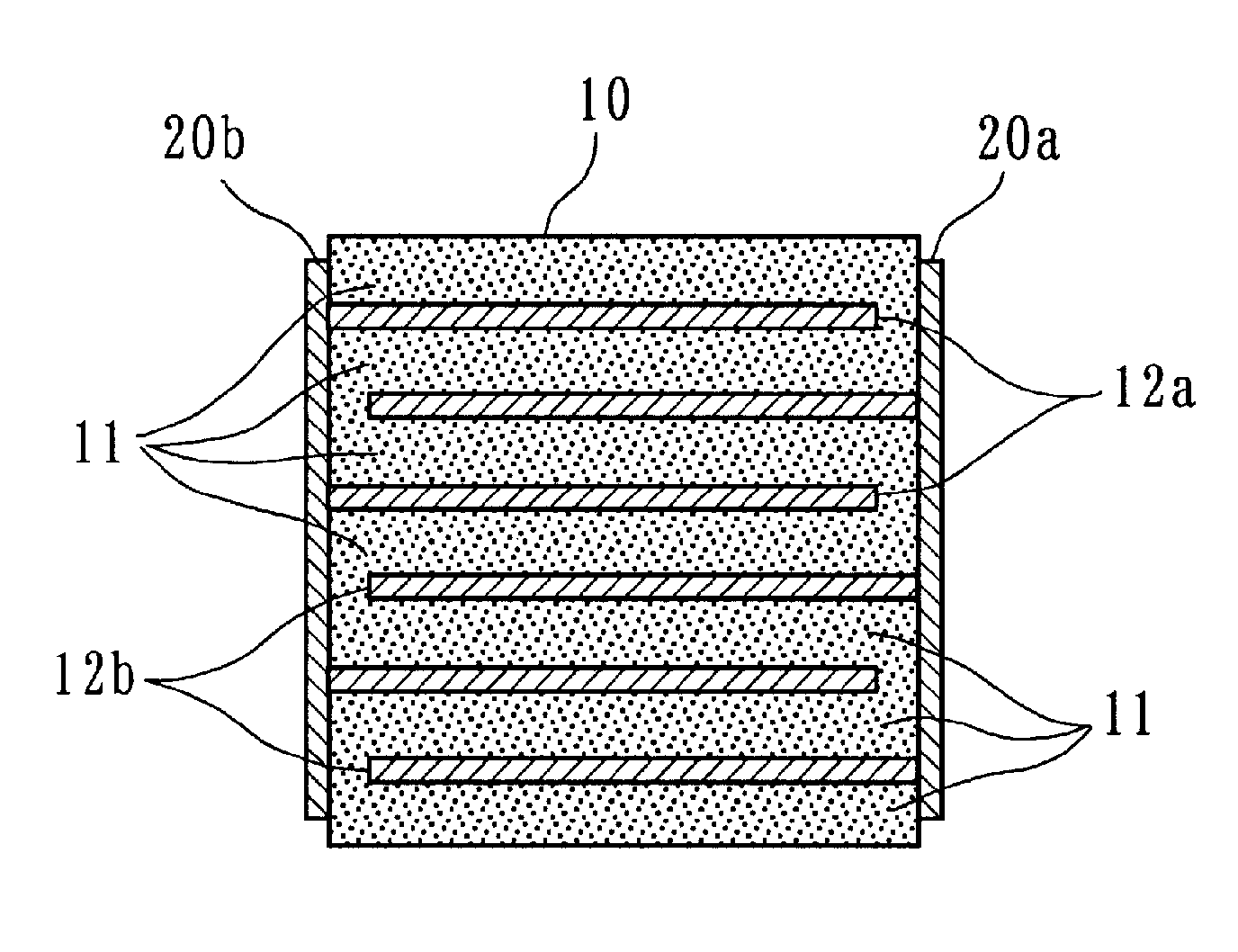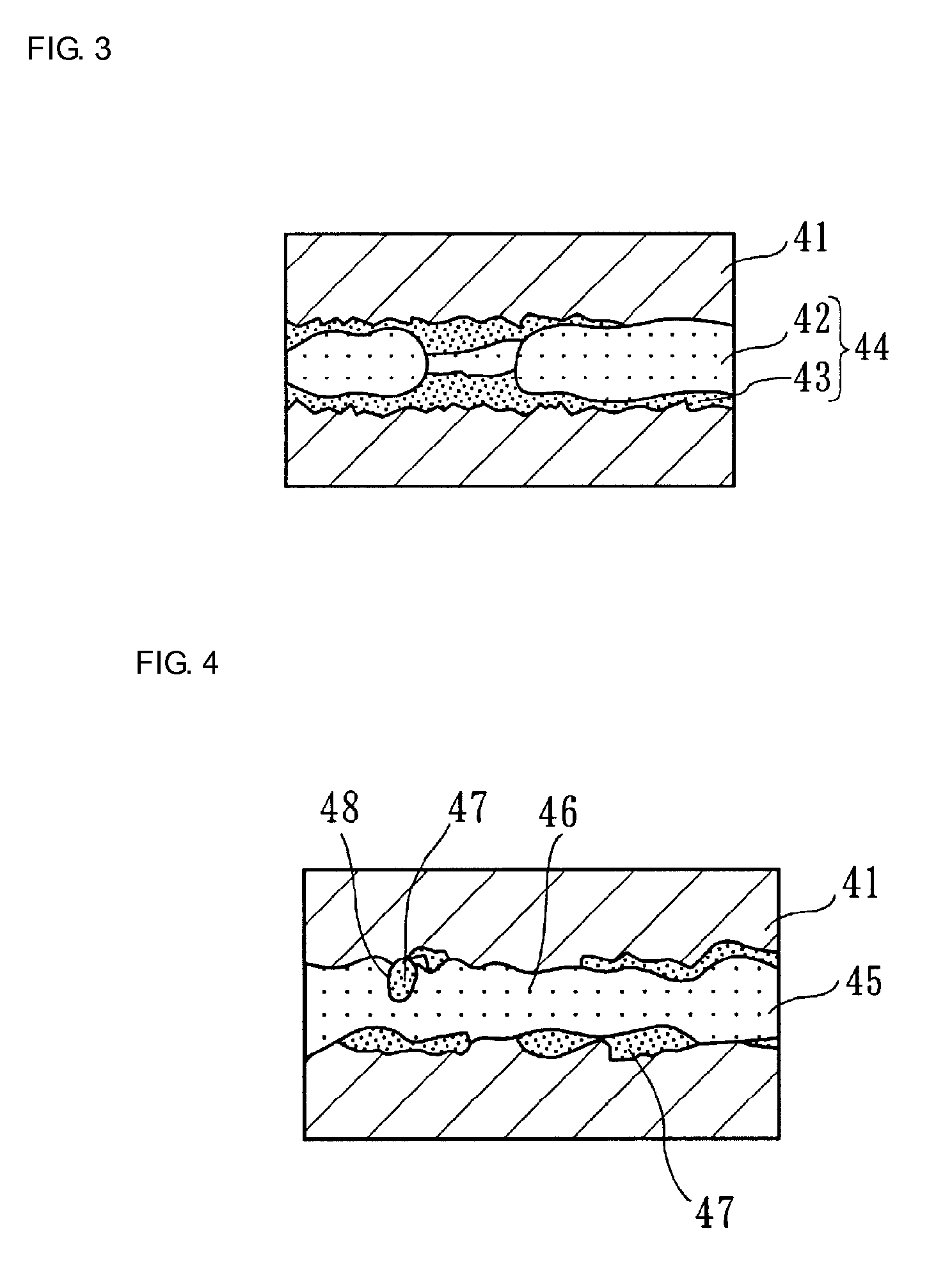Piezoelectric device
a piezoelectric ceramic and piezoelectric technology, applied in the direction of basic electric elements, electrical apparatus, printing, etc., can solve the problems of difficult to achieve piezoelectric characteristics, and compositions of the existing pzt piezoelectric ceramics disclosed in the prior, and achieves easy oxidation, suppresses copper oxidation, and increases piezoelectric constant
- Summary
- Abstract
- Description
- Claims
- Application Information
AI Technical Summary
Benefits of technology
Problems solved by technology
Method used
Image
Examples
example 1
[0096]Powders of Pb3O4, TiO2, ZrO2, NiO, and Nb2O5 were prepared as ceramic raw materials, and predetermined amounts of the ceramic raw materials were weighed and mixed so that compositions shown in Table 1 were obtained. Each mixture was wet-milled for 16 hours and calcined for 2 hours at 850° C. to obtain a calcined powder of a perovskite complex oxide represented by compositional formula (I):
Pb[(Ni1 / 3Nb(2+b) / 3)zTixZr1−x−z]O3 (I)
[0097]The resulting calcined powder was mixed with a binder and pure water to obtain a ceramic slurry, and ceramic green sheets having a thickness of 60 μm were prepared by a doctor blade method.
[0098]A conductive paste containing 85 wt % of a copper powder and 15 wt % of a nickel powder was prepared and applied on the ceramic green sheets by screen printing to form conductive layers having predetermined patterns.
[0099]The ceramic green sheets with the conductive layers thereon were stacked in a predetermined direction, and the resulting stack was sandwic...
example 2
[0113]Ceramic raw materials the same as those in Example 1 were used. Predetermined amounts of raw materials were weighed and mixed to prepare compositions shown in Table 2. Each mixture was wet-milled for 16 hours and calcined at 850° C. for 2 hours to obtain a calcined powder composed a perovskite complex oxide represented by formula (IIa):
Pb[(Ni1 / 3Nb(2+b) / 3)zTixZr1−x−z]O3 (IIa)
[0114]In other words, the blend molar ratio α of lead, which is the A-site component, to the B sites was varied, and calcined powders of Sample Nos. 41 to 47 were obtained.
[0115]Piezoelectric devices of Sample Nos. 41 to 47 were then made by the same method and procedure as in Example 1, and the piezoelectric constant d33 and the Curie temperature Tc were measured.
[0116]Table 2 shows the compositions, the piezoelectric constants d33, and the Curie temperatures Tc of Sample Nos. 41 to 47.
[0117]
TABLE 2PiezoelectricCurieSamplePbα(Ni1 / 3Nb(2+b) / 3)ZTixZr1−x−ZO3constant d33temperature TcNo.αbzbz / 3x(pm / V)(°c)41**1...
example 3
[0121]The ceramic raw materials described in Example 1, BaCO3, SrCO3, CaCO3, Nd2O3, and Bi2O3 were prepared, and predetermined amounts of these raw materials were weighed and mixed to obtain compositions shown in Table 3. Each resulting mixture was wet-milled for 16 hours and calcined at 850° C. for 2 hours to obtain calcined powders composed of perovskite complex oxide represented by formula (IIb):
Pb1.000−aMea[(Ni1 / 3Nb2.150 / 3)0.2Ti0.4225Zr0.3775]O3 (IIb)
[0122]In other words, α was set to 1.000, z was set to 0.2, bz / 3 was set to 0.010, x was set to 0.4225, and part of lead in the A sites was substituted with a metal element Me to obtain calcined powders of Sample Nos. 51 to 58.
[0123]Piezoelectric devices of Sample Nos. 51 to 58 were then made by the same method and procedure as in Example 1. Their piezoelectric constants d33 and Curie temperatures Tc were measured.
[0124]Table 3 shows the compositions, the piezoelectric constants d33, and the Curie temperatures Tc of Sample Nos. 51 ...
PUM
| Property | Measurement | Unit |
|---|---|---|
| Curie temperature Tc | aaaaa | aaaaa |
| molar ratio | aaaaa | aaaaa |
| thickness | aaaaa | aaaaa |
Abstract
Description
Claims
Application Information
 Login to View More
Login to View More - R&D
- Intellectual Property
- Life Sciences
- Materials
- Tech Scout
- Unparalleled Data Quality
- Higher Quality Content
- 60% Fewer Hallucinations
Browse by: Latest US Patents, China's latest patents, Technical Efficacy Thesaurus, Application Domain, Technology Topic, Popular Technical Reports.
© 2025 PatSnap. All rights reserved.Legal|Privacy policy|Modern Slavery Act Transparency Statement|Sitemap|About US| Contact US: help@patsnap.com



